Sony Alpha 350 Live View tested
The Sony Alpha 350 14.2 megapixel DSLR pioneers a new type of Live View, related to Olympus’s original Mode A of the E-330 where a beamsplitting arrangement allowed a video CCD to view the actual focusing screen of the SLR system.

The standard default Live View image – by pressing DISPLAY when LV is active, the screen cycles from this to a display with a small histogram in the bottom left corner and no image settings information, then to one with no histogram or information at all on the image, then back. The shooting settings and EV scale remain present permanently.
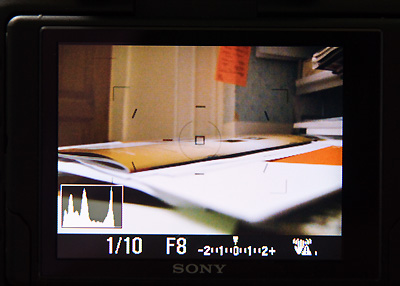
The difference between the Olympus method and Sony’s system is that no light is lost from the A350 optical finder, as a physical switch changes the lightpath instead, blocking off the viewfinder with a shutter. At the same time, the lower front face of the mirror prism shifts its angle and position slightly; this diverts the view of the focusing screen to a CCD and lens assembly positioned to the left of the eyepiece, via a 45° mirror prism placed above it.
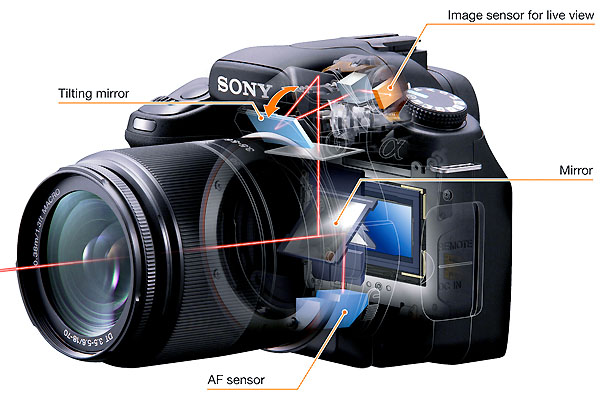
The entire operation is purely mechanical and involves hardly any pressure on the small Live View/OVF switch next to the prism on the right hand top plate of the camera. The A350 does not have to be switched on to make the change.
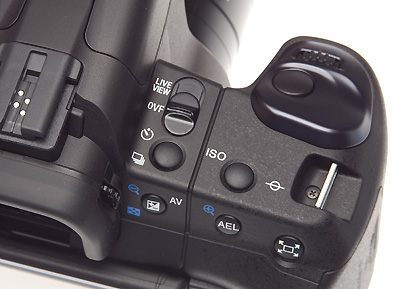
The LV/OVF switch has a very light action and is mechanical – it works when the camera is switched off. The Smart Teleconverter button (see later comments) is seen on the right hand extreme of the upper back, for thumb use.
When you do switch on, a live viewfinder image appears in 0.2 seconds reaching full brightness at 0.25 seconds – by this time the camera has also checked its CF card, executed autofocus and exposure setting, and is ready to shoot if you already have your finger on the shutter.
Making the exposure blanks out the Live View because the mirror has lifted. If you switch ‘Auto Review’ (chimping mode!) off, LV returns in under 0.2 seconds. If you enable Review, there is a blackout delay of exactly one second before the image just shot appears on screen, and according to your preferences, it will be displayed for 2, 5 or 10 seconds.
Movie – review and LV resumption
The screen blacks out for just 0.1 seconds between the end of review, and the return of a Live View image; the same delay occurs when you interrupt Live View by first pressure on the shutter release.
These timings are all comparable to similar DSLRs, such as the Nikon D60 with its start-up time of 0.19 seconds and no Live View. Overall, the operation of the Alpha 350 is slick and responsive and gives the impression of ‘real time’ without delays for the Live View image to build or react to light levels and white balance.
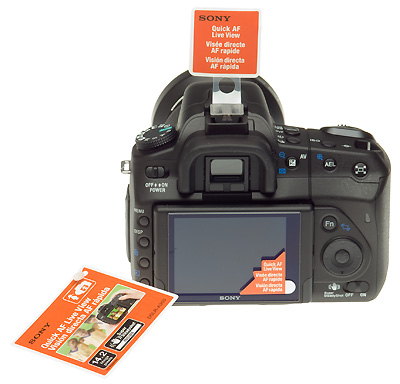
This, of course, is what Sony claims with multiple labels attached to new cameras proclaiming ‘Quick AF Live View’ as the unique selling point for this and the sister 10 megapixel Alpha 300. Because the image is just a video view of the focusing screen, the 9-point AF sensor as used for regular autofocus remains active. The Live View adds to the focus-point highlighting of the finder screen an electronic overlay which identifies not just the main focus point, but all the sensors active during Wide Area focus. This is a valuable benefit of LV. You can still press the joypad to select centre spot focus or move the focus point round, depending on the AF mode used.
The other big benefits of LV are greatly improved exposure and white balance accuracy. Although the video sensor is not the actual CCD used to take the picture, it offers a reasonable analysis of the scene. One display mode for LV shows a small semi-transparent mono histogram in the lower left corner of the 2.7 inch screen, and a few tests proved that it does match a final JPEG histogram accurately enough to fine-tune exposure on screen.
LV reflects both WB and +/- over-ride or manual exposure adjustments. It is a delight to set manual, and watch the small -2 to +2 exposure indicator hit zero at exactly the point where the viewing screen looks perfect. You can set manual exposures visually, without any reference to this scale, by judging the LV. It does not work with purely manual lenses however, and a test with T-mount bellows showed that auto gain then compensates over a wide range (you can get within two stops, but no more accurate). It works fully with D-type Alpha lenses.
The LV CCD sensitivity is linked to the camera ISO setting and metering, though it actually appears to have a regular auto-gain function reflected in the quality of image. In low light you get a grainy LV just like a noisy low-light camcorder image, in good light you get a cleaner image, but it does not matter whether you set ISO 100 or 3200. The longer exposure time given also reduces the frame rate (frequency) and causes lag and smear effects when recomposing shots in poor light levels.
In normal conditions, LV brightness will show any degree of underexposure down to black, but is capped for overexposure probably to prevent damage to the CCD or screen. It will briefly display extreme overexposure but reverts to showing the +2 result for all settings over +2. Similarly, if you go from 30 second exposure to ‘Bulb’, the display immediately normalises brightness and ignores this unknown variable. Overall, the way the LV reflects real exposure adjustments is intelligent and useful. It will help teachers or salesmen demonstrate how to use Manual exposure and +/- over-ride.
Regular exposure metering without LV uses 40 zones on the Alpha 350. With LV, this changes to 1200 zones which slightly outdoes Nikon’s professional 1002-zone Color Matrix II. The usual Evaluative, Centre Weighted and Spot modes can be set and the range is EV2 to 17, compared to EV2 to 20 for regular TTL. Mladen Sever (Dyxum.com) says that for centre weighted and spot readings the regular metering cells take over, and the only setting using the CCD is Evaluative – the manual, in contrast, says that the modes apply to LV with the altered sensitivities as listed, which implies they may be handled from the LV sensor.
The accuracy of the LV metering is exceptional, but the same can be said for most systems which meter off a CCD sensor receiving the full frame image. White Balance also improves, without being artificially over-corrected. It is not a precise match for the reviewed result, which often looks a little less saturated and may have a secondary colour cast.
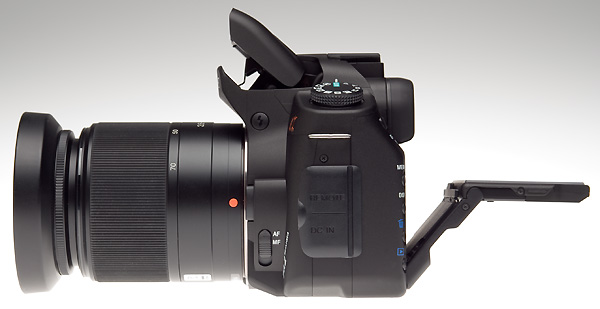
The LV screen of the A300/350 can only be angled for landscape format viewing, a range of positions suitable for everything from ground level macro to tripods at chest height and cameras held up to see over crowds or barriers. It does not rotate for self-portrait viewing, or hinge vertically for a similar range of angles on portrait format shots.
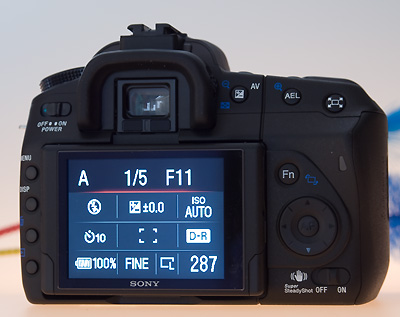
The normal screen as seen in Optical Viewfinder Mode is exactly the same as the A200.
In Optical Viewfinder Mode, shooting information on the rear screen rotates for horizontal or vertical display but Function button accessed settings changes do not. In LV mode, shooting information does not rotate at all.
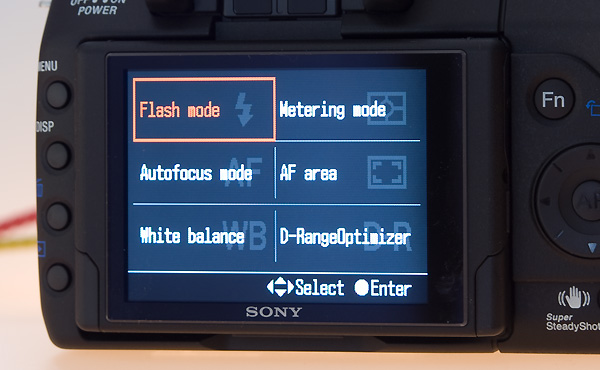
When you use the Function button to reach the six adjustment panes (Flash Mode, Metering Mode, Autofocus Mode, AF Area, White Balance and D-Range Optimisation) the menu screen for these replaces the LV image entirely.
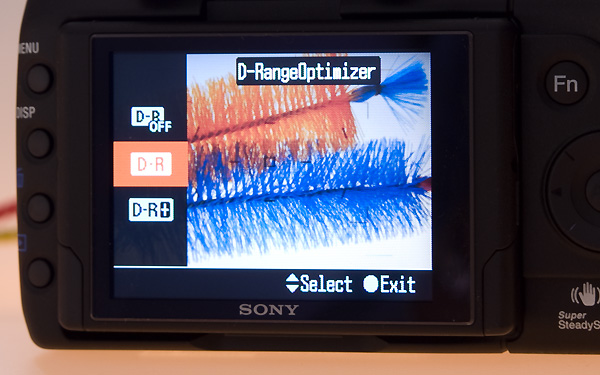
When making Fn adjustments, the LV continues to be visible. No effect is seen with DRO, but WB adjustments show the effect as you select choices.
However, once you hit the joypad centre button to enter one of these adjustments, the LV image appears like a wallpaper behind the settings. Only in WB adjustment mode does it then reflect the changes as you make them, and this is most valuable; you can adjust Kelvins (2500 to 9900), Magenta/Green CC shift (this appears to be +45 to -45 in Wratten CC values, in steps G9 to M9). Again, the previewed effect is not dead accurate but reflects relative results.
The effect of DRO (dynamic range optimisation for highlights and shadows) is not previewable, but the greater accuracy of the 1200-zone LV metering improves Auto DRO+ results.
The A350 and A300 also have WB bracketing of three frames in either Hi (20 mired) or Lo (10 mired) steps, and a fast Custom White balance setting. Regular exposure bracketing is sadly limited to just three frames, either 0.3 or 0.7 EV steps, which will not satisfy many demands.
Whether in LV or OVF mode, the AEL (exposure lock) button has a useful second function. Though it does not switch the reading to a spot reading (option not present in these models) it activates a secondary spot reading, displayed alongside the regular centre-weighted or matrix metering on the EV scale in the viewfinder or on-screen. This exposure marker moves relative to the main exposure marker to show how your selected spot relates; if you set manual exposure, this becomes like using a meter with a highlight/shadow comparison up to two stops either way. It would be better if the EV scale was not limited to +/- 2 stops.
Because LV is taken from the focusing screen, it always shows the screen markings. Use for video recording would not have been much value, as the resolution of the LV is only 320 x 240. Nor would a video feed be very useful for computer remote tethered operation, something included for the Sony Alpha 700 (software and cable bundled with the camera) but impossible with the 200, 300 and 350.
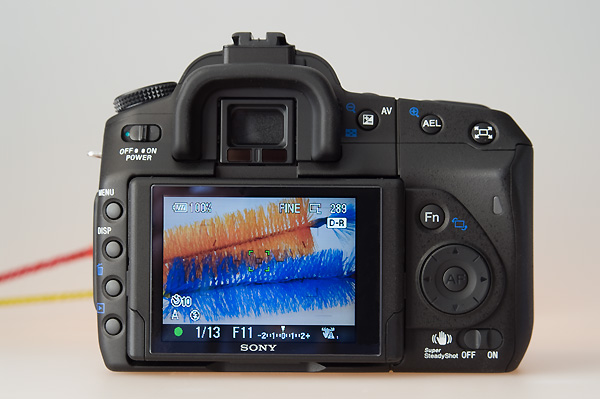
The LV shows almost the entire focusing screen, which itself shows 95% of the frame. The result is around 90% for the LV composition, unlike ‘bridge’ cameras such as the Canon G9 or older Sony DSC R-1 where the live preview screen shows 100%. Fitting the LV system also reduces the space available for the roof prism, so the OVF has a very low magnification of just 0.74X. Compared to 0.83X for the non-live-view Alpha 200 and 0.9X for the semi-pro, glass prism Alpha 700 this is a very small SLR finder indeed, and it tends to push you into use LV more often. Sony needs to make an accessory eyepiece magnifier like the Olympus ME-1 Magnifying Eyecup with its 1.2X factor. Owners of some Olympus and Canon models (300D, 350D, 400D) won’t see the finder as especially small – they are used to tunnel vision!
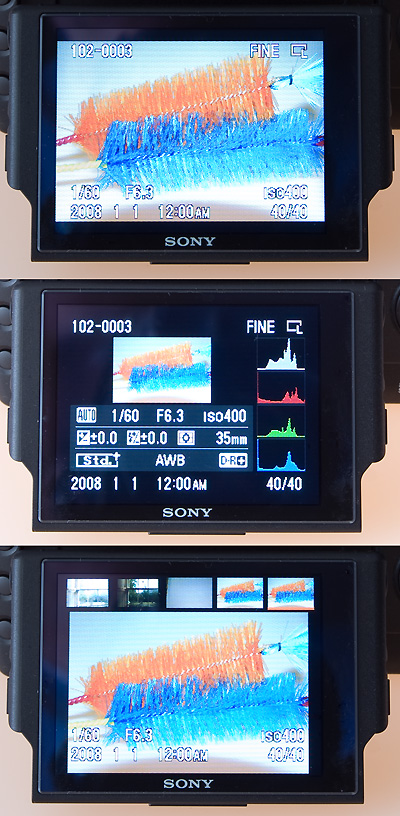
There are three review modes – although the composition has shifted slightly here, the angle of view was untouched from the preview LV shown above, so you can judge about how much the final shot differs from the LV in cropping (here the camera has moved a little to the right). The review modes include RGB histogram and 5-image filmstrip.
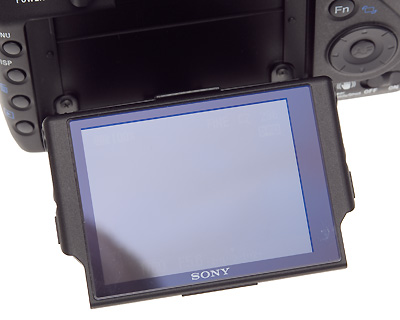
This studio shot was taken with the screen fresh out of the maker’s box. Even just opening it up left marks on it!
In full sunlight or even bright shade on a sunny day, the LV screen can be impossible to view, especially when aimed upwards. Only a vague idea of composition is possible without shading the screen. It is also highly polished in finish, and reflective despite a coating, which tends to smear at the slightest touch leading to compulsive repeated screen cleaning. Unlike the Olympus E-3 or Sony R-1 it can not be flipped round to turn it off and protect it. Some kind of viewing hood and protector would be desirable, but the camera is already fairly thick front-to-back and the screen sits far behind the eyepiece; also, there is no apparent provision for fitting a cover or hood.
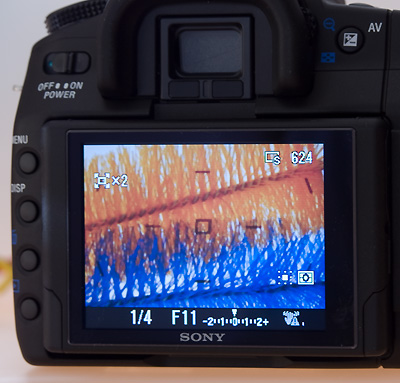
LV allows digital zoom modes of 1.4X and 2X when shooting JPEGs only. The magnify button on the right hand end of the camera is disabled when shooting raw. It can not be used to check focusing as the enlarged video view is far from sharp, at 2X it uses only 160 x 115 pixels (or the equivalent cropped to the 35mm shape). There is no digital enlargement or interpolation, just a crop applied in-camera to match the view; at 1.4X you get Medium sized JPEGs, 3264 x 2176 (7.1 megapixels), at 2X it’s 2416 x 1600 (3.8 megapixels). Sony call this function a ‘Smart Teleconverter’ but really it’s just in-camera cropping of the substantial 14.2 megapixel, 4952 x 3056 pixel image. The crops on the 10 megapixel A300 are proportionately lower in pixel count.
Equip the A350 with 75-300mm kit lens and with 2X crop you have the equivalent of a 900mm lens (by 35mm full frame standards) on an image size good enough for half-page quality magazine or tabloid newspaper repro. Many owners will be very happy with this function.
Movie – 2fps Live View continuous mode
In single frame drive mode with conventional autofocus, the after-shot hiatus limited to 1/10 of a second. If you set these cameras to use continuous drive with LV – 2fps only for the A350, 2.5fps for the A300 – LV blanks out for each shot, but restores itself for just enough time to continue aiming and composing. In practice, I got 12 frames in 7 seconds with Fine JPEG which is 1.7fps not 2fps, using a SanDisk Extreme IV card, and the camera seemed happy to keep shooting at this rate with occasional slight hiccups until the card was full. There were early rumours that the screen blanked out continuously during sequence shooting, and these prove to be false.
Reviewing images when sequence shooting doesn’t happen – even if you set preferences to review for just 2 seconds, only the final frame in any sequence will be shown. RAW shooting does not prevent the continued intermittent live viewing either. Setting DRO+ to be active slows down sequence shooting, with longer dark intervals, but the view still returns briefly before each frame.
For most sequence shooting the direct OVF will be used anyway, and then the cameras can achieve 2.5fps (A350) and 3fps (A300) with continuous JPEG, the true speed affected again by DRO settings. Buffer capacity is only 3 RAW+JPEG for either the 350 or 300; shooting RAW only, the 350 manages 4 frames and the 300 a more useful 6. Again, DRO+ will slow things down considerably. With a SanDisk Extreme IV, I got 8 RAW frames at 2.5fps with the S350, which is double the official count; with a Kingston Ultimate 266X, only 6, despite it being a faster card.
![]()
The camera includes a manual Pixel Mapping function, which at first seemed welcome with a 14.2 megapixel CCD. However, it only affects the Live View CCD, and is used if persistent dots appear on the LV screen. It does not relate to the pixel mapping of the main sensor, which will probably auto-calibrate during the first switch-on cycle of each calendar month, just as previous Konica Minolta and Sony DSLR sensors have done to date.
The SSS (Super Steady Shot) sensor-based image stabilisation of the Sony DSLR series has no effect on the stability of the Live View image. Instead, a camera shake warning is shown on LV bottom shooting info strip, along with a bar graph metering the level of shake being corrected. It is easy to adjust your grip and posture to minimise the shake, before allowing the 2.5 to 3.5 stops of stabilisation correction to eliminate it entirely.
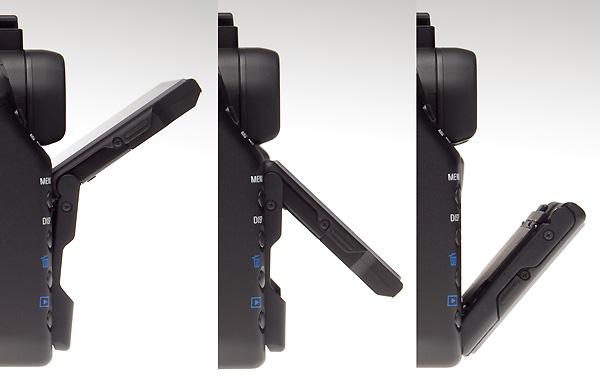
The possible angles of the A350 screen are limited to horizontal orientation: the maximum possible ‘forwards’ tilt is shown left (not of much use) and the maximum downward tilt (for holding the camera overhead) at the right.
All told, Sony’s Quick AF Live View is not the complete or final answer any more than Olympus’s pioneering in-prism design, or the many live feed off sensor solutions from Canon, Nikon, Pentax, Olympus, Samsung and Panasonic. It is one of the best compromises yet in terms of user friendly functions and suitability for full-time use. While failure to preview sharpness or focus well enough is a failing, previewing manual or over-ride exposure and white balance without entering a special ‘disable auto gain’ mode is an equal strength.
Testing the 2X Smart Converter on my 100-300mm APO D, I found that the lens was really not up to it wide open though detail was resolved well enough – it simply lacks the bite needed to show good use. It was extremely difficult to keep ducks at 200 yard distance centered in the frame – which is restricted to the centre AF sensor only when using this mode – and my attempt to frame a patient water rat resulted only in a shot with a rat’s tail disappearing from the edge!
Since ACR 4.3.1 does not convert these .ARW2 files, and Sony’s IDC does not do the CA corrections I need to be able to use my CZ 16-80mm properly, the only examples I have been able to assess are either in-camera JPEGs or similar IDC conversions. I don’t believe that these show me what I need to know about image quality, and that report will come later. Just let’s say that comparing in-camera JPEGs, the A350 has excellent resolution; shadows are somewhat crushed and while the LV enabled very accurate exposure, I don’t expect to see this sensor testing out as one with a huge dynamic range. Update: using ACR 4.4.1 it turns out to have very good dynamic range, and this can be accessed by using minimum contrast setting and AdobeRGB on the camera for JPEGs. In fact it has good shadow detail, and the crushing I noticed was only on standard JPEGs without any user adjustments.
The battery life indicator on our camera showed 75% after the first 200 frames, with extensive deletions and persistent use of the LV and review functions, but very little use of the built-in flash. The indicates that the suggested 450 frames to Sony’s standard – including 50 per cent flash use – is realistic. It’s 200 less than a non-LV equivalent with the same type of InfoLithium cell. Prolonged use of the LV will reduce shooting time left, and here having the percentage battery life display comes in useful. Compare it to under 200 shots per battery charge on the Canon EOS 450D using live view, and you realise how efficient the Sony solution is.
– David Kilpatrick

I am a retired newspaper photographer. I have two A300s with five lenses from 11mm to 300mm including a Minolta 50mm f/1.4. I love the system and use it for weddings and event photography. I don’t know why I would need any more then 10.2 MP. It is my understanding that the A350 gets a little video noisy in low light? I particularly like the wireless flash and I ofter use three flashes on stands – works great.
David…
I probe the a350 and I saw the live view image a little slow. How do you say when a image is slow in a video?? is like the record speed is slow, lower 30fps.
I do not know, but I thing that ths sensor is a CCD sensor compact camera and if Sony hope launch a new camera with LV I hope this has a ClearVid sensor.
Damn. I’ve been waiting for a long time for a truly usable live view on a DSLR and I was quite excited by the advent of th a300 and the a350…but maybe it’s too soon yet. 95% view…I have a Sony R1 and that’s the kind of live screen I want, 100% view and rotatable as well as tiltable. Then I read the regular viewfinder isn’t all that good and the camra uses expensive proprietary Sony batteries. And finally the kit lenses which seem to be a bit of a question mark. I bought the R1 for its Zeiss lens and it is a fantastic piece of glass…looks like I’ll be waiting a bit longer. Maybe this a900 will fit the bill.
thanks for an excellent review.
Fisher
Jim, I do not really understand what you were asking. You take a picture in either of the crop modes by pressing the shutter button, that’s all. They are not preview modes, they are shooting modes. That is fully and clearly explained in the article along with the exact size of the images produced. If you intend to use the crop mode, get the A350. The extra pixels make a difference with the smaller images sizes.
David
Please tell me if you can take a picture after using either of the crop modes? Thank you.
Would you recommend the A350 over the A300? ($100.00)
Do I need the 14.2 (350) vs the 10.2 (300)? Need some advice before the purchase.
Also thinking about the vertical grip?? $249.99 at Sony USA. Any input for the above would be appreciated.
Thanks,
Jim
Hi, thanks for your exhaustive review of the live preview function.
Since 2005 i use a Konica Minolta A2 as my primary camera. I have been waiting for a functional live preview D-SLR since i got my A2 and wondered if you have any experience with the A2 and could give me some info?
What i like with my A2:
+Live Preview(used a lot)
+Adjustable screen(used a lot)
+Wireless flash
+Not a lot of *menuing* eg. a lot of buttons and dials.
Not so good tho is:
-BAD focusing in dim light.
-BAD noise in any mode over ISO100
-No optical viewfinder makes manual focusing a pain and virtually unusable.
I wonder if a A350 purchase will be a step-up for me? I see myself as a Semi-Pro photographer, but the a350 is marketed as a family-cam? The A2, in its days, were considered as a semi-pro camera, but i guess(and hope) there is more to the a350 anyways, 3 years later?
David-
Thanks for your most recent review on the Sony A350. I am getting ready to purchase one and I have a few questions.
Could you please explain what actually happens during LV if you change WB,Exposure, etc. Can you actuallu see it on the screen.
Are you able to edit pictures in the camera similar to Nikon and Pentax (filters, WB, etc.) actually on the screen?
Thanks again!
Henry B.
I only want to use Live View in Sony Alpha 350 like I do in compact digital cameras… it’s possible?
Any Incovenient?
Thanks.
It really irritated me after I purchased my A700 in December 2007 to later learn that the Live View 300 and 350 were on the way. And of the course the auto pop up flash which the A700 does not have. Great DSLR though. I still want that live view like my Sony F828.
Is the crop mode in the A300 and A350 like the “trim” mode of the Sony F828; I find that really useful for my super macro work?
Thanks,
Jim Hathaway
Reply: yes, it’s a crop mode, not a digital interpolation mode – it cuts down the image size, exactly as described in the article – DK.
Thank you Daved, I will write you when I get something…
Ref the magnify button – no, it only has that function, Smart Teleconverter. Ref the dioptre – I believe this fits inside the eyepiece, not over the outside – the Pentax device fits over the outside. It will fit, but slightly loosely. Adding some layers of cellulose tape on the runners which slot round the eyepiece should make it fit tightly.
David
Hi, the dimentions of the Alpha Eyepiece Corrector Diopter is the 18x14x5mm, Do you know what is the dimentions of the Pentax Magnifies O-ME53??
Can the magnify(CROP) button be programmed for anything else? The crop only function does not seem very exciting.
Yes, it would probably work fine. I can use the Olympus eyepiece with a Pentax adaptor from my Seagull 2.5X angle finder, it fits well. I just have to turn off eye start and Auto Off/w Viewfinder functions, to disable the eye sensors.
The only reason the makers do not fit a higher magnification eyepiece directly is that it limits some spectacle wearers and people with extreme dioptre correctionsm and makes it harder to get the eye centered exactly. Many people do not use SLR viewfinders properly, it’s surprising how some have their eye a long way off and think that they see the frame, when they are just viewing the middle of the screen!
David
I could to use the glass of the magnifies Pentax O-ME53 (1.18X) and adapt to Sony FDA-ECF05 Alpha Eyepiece Corrector Diopter and put it in the a300 or a350.
What do you think??
Yes, the viewfinder is very small. It is possible to use magnifiers. I have the Olympus one here, and it works well, but it does not fit properly and it interferes with the eye sensors. A properly designed 1.2X magnifier would be very good with all the Sony models – it even makes the A700 viewfinder look better (huge). But on the A350, it is the difference between very small and normal size.
David
Hi Daved, excellent review…
One question…
This a350 is very tenative, but, Is the OVF very small??
Is possible to use any VF magnifies in this Alpha??
Thank you and excuse my english…
Nice report DK…I am going to replace my KM5D with the A200, and then as replacement for my pNs cameras I sold to generate funds to purchase the A700 with, I will eventually get one of these live view models.
I used to love live view for certain things and it’s high time I got back to using a live view cam for those things.
Let me tell you though…the Sony Alpha A700 is doing some real good things for me as you can see on this ISO3200 Monday Night football indoor shoot.
http://www.rockriverfootball.com/raptors/v/rock+river+raptors+cifl+pre-season/
Thanks again for the report, DK.
http://www.sonolta.com